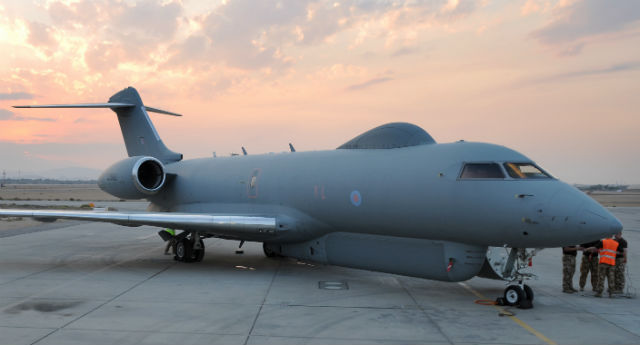The UK could use its Raytheon Systems Sentinel R1 battlefield reconnaissance aircraft as a national adjunct to NATO's alliance ground surveillance (AGS) fleet of unmanned air vehicles, says Royal Air Force chief of the air staff Air Chief Marshal Sir Stephen Dalton.
Using NATO's Boeing E-3-equipped airborne early warning and control system force and the RAF's contribution of E-3D Sentry aircraft as an example of such an arrangement, Dalton says: "Sentinel could form part of NATO AGS, along with [Northrop Grumman] Global Hawk UAVs."
 |
|---|
Crown Copyright |
The UK coalition government's Strategic Defence and Security Review (SDSR) of September 2010 proposed retiring the RAF's relatively new fleet of five Bombardier Global Express-derived Sentinels, once the type was no longer needed to support NATO-led activities in Afghanistan. However, the Ministry of Defence in May 2012 indicated its intention to provide a "contribution in kind" to the multinational AGS programme, with the manned surveillance aircraft being its most applicable solution.
Speaking at a Royal Aeronautical Society lecture in London on 10 June, Dalton said the at-risk Sentinel system has proven its ability to deliver "timely, and fully releasable intelligence products" through operations performed over Afghanistan, Libya and Mali.
The RAF deployed one of its Sentinels and supporting personnel to Dakar in Senegal between January 2013 and late May, following a request from the French government for product from its dual synthetic aperture radar and ground moving target indication sensor during its Serval operation.
"Sentinel enabled France to understand the behaviour of the militants, and supported the movement of its troops on the ground," he says. Offering such a system to support future multinational operations via the AGS programme framework would benefit the UK, he believes, as it could be "flexed from NATO to national operations, as required".
A formal decision on whether to retain the Sentinel capability will be made as part of the UK's next SDSR process, which is due to report its findings in 2015.
Approved late last year, the AGS programme's scope was reduced over several years, due to cost constraints, eventually settling on a deal for five radar-equipped Block 40 Global Hawks, to achieve initial operating capability during 2016.
Meanwhile, Dalton says the UK needs to invest in technologies to enable its future remotely piloted air systems to be capable of operating in contested airspace. He also notes that such equipment - as with the RAF's General Atomics Aeronautical Systems Reapers now used in Afghanistan - will be operated following "the same legal and ethical framework" as its manned combat aircraft.
Source: Flight International



















